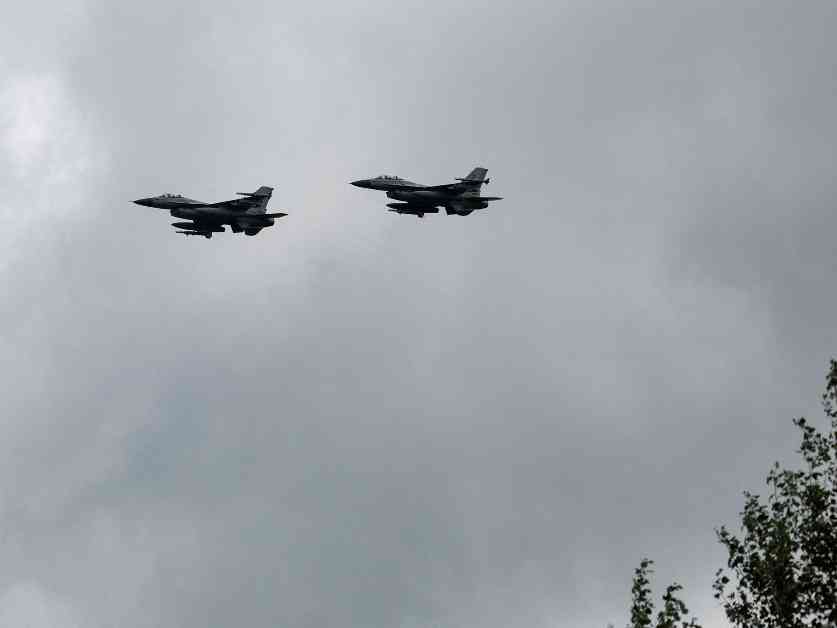Ukraine President Zelenskyy Dismisses Air Force Commander Following F-16 Crash
In a bold move to prioritize the safety and well-being of military personnel, Ukrainian President Volodymyr Zelenskyy has made the decision to dismiss the country’s air force commander, Mykola Oleshchuk. This decision comes in the wake of a tragic incident where an F-16 warplane, recently acquired from Western partners, crashed during a Russian bombardment, resulting in the loss of the pilot’s life.
Zelenskyy’s announcement to relieve Oleshchuk of his duties was made public on the presidential website, sending shockwaves throughout the military establishment. The President emphasized the need to protect and care for all soldiers, highlighting the importance of bolstering the army’s leadership at a critical time.
The newly appointed acting air force commander, Anatolii Kryvonozhko, will now lead the air force as the country navigates through challenging circumstances. The abrupt dismissal of Oleshchuk underscores the urgency and seriousness with which the Ukrainian government is approaching the situation.
Oleshchuk’s departure from his role as air force commander coincided with a heated exchange between him and a prominent lawmaker, Mariana Bezuhla, who serves as the deputy head of the Ukrainian parliament’s defense committee. Bezuhla raised allegations that the F-16 crash was a result of being downed by a Patriot air-defense system, a claim that Oleshchuk vehemently disputed.
The controversy surrounding the cause of the F-16 crash has prompted a thorough investigation involving US experts, who have joined forces with Ukrainian authorities to unravel the circumstances leading to the tragic incident. While initial reports suggest that the crash was not a result of Russian fire, multiple factors, including pilot error and mechanical failure, are being examined as potential causes.
As the investigation unfolds, questions linger about the efficacy of the F-16 warplanes in Ukraine’s ongoing conflict with Russia. Despite being hailed as advanced supersonic jets capable of delivering modern weapons used by NATO countries, military analysts caution that the planes may not significantly alter the balance of power given Russia’s formidable air force and sophisticated air defense systems.
The arrival of the F-16 warplanes in Ukraine had been viewed as a strategic move to counter Russia’s air superiority and provide Ukrainian forces with a means to strike back at Russian bases beyond the front lines. However, the recent crash serves as a stark reminder of the risks and challenges associated with operating such high-performance aircraft in a volatile conflict zone.
Subheading 1: Dismissal of Air Force Commander Sparks Controversy
The dismissal of Mykola Oleshchuk as the air force commander has sparked controversy and raised questions about the circumstances leading to his abrupt removal from the position. While President Zelenskyy cited the need to prioritize the safety of military personnel as the primary reason for the dismissal, speculations abound regarding potential underlying factors that may have contributed to Oleshchuk’s downfall.
Oleshchuk’s outspoken criticism of lawmaker Mariana Bezuhla, who accused the F-16 crash of being caused by a Patriot air-defense system, added fuel to the fire and intensified the tensions surrounding the incident. The clash between Oleshchuk and Bezuhla underscored the complexities and challenges faced by Ukrainian authorities in managing the aftermath of the tragic crash while navigating political pressures and public scrutiny.
Subheading 2: Investigation into F-16 Crash Raises Concerns
The ongoing investigation into the F-16 crash has raised concerns about the operational safety and effectiveness of the advanced warplanes in Ukraine’s military arsenal. With conflicting accounts and allegations surrounding the cause of the crash, the need for a thorough and transparent inquiry has become paramount to establish accountability and prevent future incidents.
The involvement of US experts in the investigation signifies the international significance of the F-16 crash and the implications it holds for Ukraine’s strategic partnership with Western allies. As the probe delves deeper into the details of the crash, questions about the training, maintenance, and overall readiness of Ukrainian forces to operate such sophisticated aircraft loom large, casting a shadow of doubt on the feasibility of utilizing F-16s in a conflict setting.
Subheading 3: Implications of F-16 Crash on Ukraine’s Military Strategy
The F-16 crash has raised critical questions about Ukraine’s military strategy and the efficacy of incorporating advanced fighter jets into its defense capabilities. While the acquisition of F-16 warplanes was seen as a significant step towards bolstering Ukraine’s air power and deterrence capabilities, the recent incident has exposed vulnerabilities and challenges that need to be addressed to enhance operational effectiveness and ensure the safety of military personnel.
The crash serves as a sobering reminder of the risks and complexities associated with modern warfare and the imperative for thorough risk assessment and mitigation strategies in deploying high-performance aircraft in conflict zones. As Ukrainian forces continue to grapple with escalating tensions and threats from Russian aggression, the lessons learned from the F-16 crash will undoubtedly shape future decisions and actions aimed at safeguarding national security interests.
In conclusion, the dismissal of the air force commander following the F-16 crash underscores the gravity of the situation and the challenges facing Ukraine as it navigates through turbulent times. The need for transparency, accountability, and effective leadership in managing military operations is more critical than ever, as the country strives to protect its sovereignty and defend against external threats. The lessons learned from the F-16 crash will serve as a catalyst for strengthening Ukraine’s defense capabilities and ensuring the safety and well-being of its armed forces in the face of ongoing conflicts and geopolitical uncertainties.



























